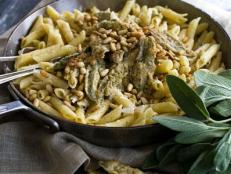Sichuan Pepper — Off the Beaten Aisle

Any food that can make your tongue tingle has got to be worth a taste.
I’m not talking a seltzer-like zippiness or even a searing chili heat. I mean literally tingling because your tongue is at once numb and buzzingly alive.
That is the power of the Sichuan pepper (also called Sichuan peppercorn). But why would you want to (albeit mildly) numb your mouth? Because aside from the basic coolness of a tingling tongue, that sensation also changes the way you taste food seasoned with the pepper, adding a wonderful punchy vibrancy and warmth unlike anything else.
First, the basics. Despite appearances, Sichuan pepper is not a true peppercorn. It is the dried rind of the berry-like fruit of the prickly ash tree. And chances are, you’ve had it before. Sichuan pepper is a basic component of Chinese five-spice powder. As its name suggests, the spice has left a serious thumbprint on the cuisine of China’s Sichuan province. It also is used in Japan, where it is called sansho.
The taste has been compared to lime zest combined with black pepper, cardamom and hot peppers. The tingling is likened to an electric charge.
In Chinese cooking, Sichuan pepper is toasted before being crushed or ground. This mutes the spice’s citrus flavors and heightens its woody notes, making for an excellent pairing with meats.
To toast the spice, add it to a dry skillet over medium heat. Stir for about one minute, or until fragrant. Cool, then grind and use.
Now that you’ve toasted it, what should you do with it?
• Blend it with coarse salt and ground black pepper, then use it as a rub for beef.
• Blend it with just salt and sprinkle it over fried chicken. Or blend it into panko to use as the breading for oven “fried” chicken tenders.
• Stir it into mayonnaise and use to make a killer tuna salad or a sandwich spread for a turkey and cheese on a baguette.
• Melt butter in a skillet, add ground (untoasted) Sichuan pepper and shrimp. Sauté until the shrimp are pink and firm, then add (still hot) to a salad of chopped fennel, avocado and diced red onion with lemon vinaigrette.
• Blend ground toasted Sichuan pepper with tomato paste, honey, cumin, cinnamon, salt and pepper. Sauté cubed chicken breasts with garlic in olive oil, then stir in the tomato paste mixture and heat. Thin the sauce with chicken broth, then serve on buns or over pasta or rice.
Heat the oven to 400 degrees F. Line a rimmed baking sheet with foil and coat with cooking spray.
In a dry skillet over medium heat, toast the Sichuan pepper, star anise and dry ginger for one minute, stirring constantly. Transfer to a spice grinder and grind until reduced to a fine powder. Transfer to a large bowl.
Add the egg to the seasoning blend, then whisk well. Mix in the scallions and salt, then add the beef and pork. Use your hands to mix well.
Form the mixture into 1 tablespoon-size meatballs.
In a large skillet over medium-high heat, heat about 1 tablespoon sesame oil until nearly smoking. Working in batches and without crowding the pan, brown the meatballs on all sides, about five minutes.
Transfer the meatballs to the prepared baking sheet. Repeat with remaining meatballs, adding oil to the skillet as needed.
When all of the meatballs have been browned, place them in the oven and roast for eight minutes.
Meanwhile, prepare the dipping sauce. In a small bowl, whisk together the sour cream, honey and salt.
When the meatballs are finished, serve them with toothpicks and ramekins of the dipping sauce.
J.M. Hirsch is the national food editor for The Associated Press. He is the author of the recent cookbook High Flavor, Low Labor: Reinventing Weeknight Cooking . He also blogs at jmhirsch.
































